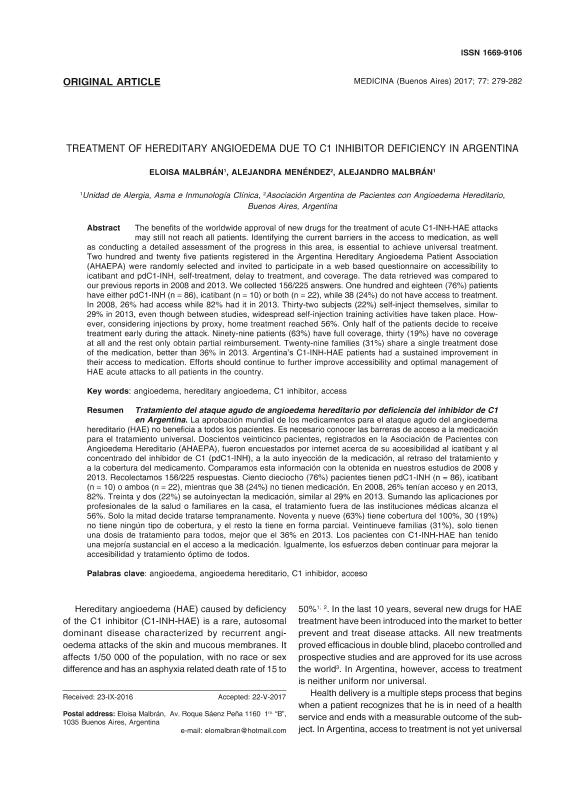Artículo
The benefits of worldwide approval of the new drugs for the treatment of acute C1INH-HAE attacks may still not reach all patients. Identifying the current barriers in access to medication, as well as conducting a detailed measurement of the progress in this area, is essential to achieve universal treatment. Two hundred and twenty five patients registered in the Argentina HAE Patient Association (AHAEPA) were randomly selected and invited to participate in a web based poll asking about accessibility to icatibant & pdC1-INH, self-treatment, delay to treatment and coverage. The data retrieved was compared to our previous reports in 2008 and 2013. We collected 156/225 answers. One hundred and eighteen (76%) patients have either pdC1-INH (n=86), icatibant (n=10) or both (n=22), while 38 (24%) do not have access to treatment. In 2008, 26% had access while 82% had it in 2013. Thirty-two subjects (22%) self-injected, similar to 28.6% in 2013, though between studies, widespread self-injection clinics have taken place. However, considering injections by proxy, home treatment reached 56%. Only half of the patients decide to receive treatment early during the attack. Ninety-nine patients (63%) have full coverage, thirty (19%) have no coverage at all and the rest only partial reimbursement. Twenty-nine of the families (31%) share one treatment dose of the medication, better than 36% in 2013. Argentina?s C1INH-HAE patients had a sustained improvement in their access to medication. Efforts should continue to further improve accessibility and optimal management of HAE acute attacks to all patients in the country. Tratamiento del ataque agudo de angioedema hereditario por deficiencia del inhibidor de C1 en Argentina. La aprobación mundial de los medicamentos para el ataque agudo del angioedema hereditario (HAE) no beneficia a todos los pacientes. Es necesario conocer las barreras de acceso a la medicación para el tratamiento universal. Doscientos veinticinco pacientes, registrados en la Asociación de Pacientes con Angioedema Hereditario (AHAEPA), fueron encuestados por internet acerca de su accesibilidad al icatibant y al concentrado del inhibidor de C1 (pdC1-INH), a la auto inyección de la medicación, al retraso del tratamiento y a la cobertura del medicamento. Comparamos esta información con la obtenida en nuestros estudios de 2008 y 2013. Recolectamos 156/225 respuestas. Ciento dieciocho (76%) pacientes tienen pdC1-INH (n = 86), icatibant (n = 10) o ambos (n = 22), mientras que 38 (24%) no tienen medicación. En 2008, 26% tenían acceso y en 2013, 82%. Treinta y dos (22%) se autoinyectan la medicación, similar al 29% en 2013. Sumando las aplicaciones por profesionales de la salud o familiares en la casa, el tratamiento fuera de las instituciones médicas alcanza el 56%. Solo la mitad decide tratarse tempranamente. Noventa y nueve (63%) tiene cobertura del 100%, 30 (19%) no tiene ningún tipo de cobertura, y el resto la tiene en forma parcial. Veintinueve familias (31%), solo tienen una dosis de tratamiento para todos, mejor que el 36% en 2013. Los pacientes con C1-INH-HAE han tenido una mejoría sustancial en el acceso a la medicación. Igualmente, los esfuerzos deben continuar para mejorar la accesibilidad y tratamiento óptimo de todos.
Treatment of hereditary angioedema due to c1 inhibitor deficiency in argentina
Título:
Tratamiento del ataque agudo de angioedema hereditario por deficiencia del inhibidor de C1 en Argentina
Fecha de publicación:
08/2017
Editorial:
Medicina (Buenos Aires)
Revista:
Medicina (Buenos Aires)
ISSN:
0025-7680
e-ISSN:
1669-9106
Idioma:
Inglés
Tipo de recurso:
Artículo publicado
Clasificación temática:
Resumen
Palabras clave:
Angioedema
,
Argentina
,
Hereditario
,
C1 Inhibidor
Archivos asociados
Licencia
Identificadores
Colecciones
Articulos(SEDE CENTRAL)
Articulos de SEDE CENTRAL
Articulos de SEDE CENTRAL
Citación
Malbran, Eloisa; Menendez, Alejandra; Malbrán, Alejandro; Treatment of hereditary angioedema due to c1 inhibitor deficiency in argentina; Medicina (Buenos Aires); Medicina (Buenos Aires); 77; 4; 8-2017; 279-282
Compartir




